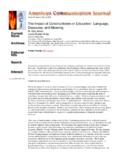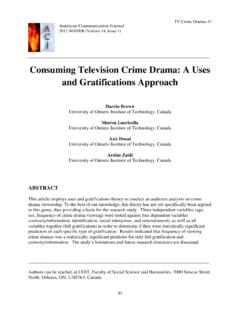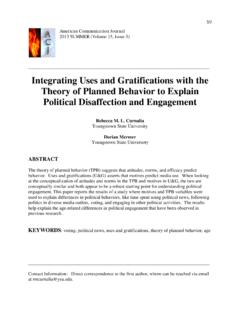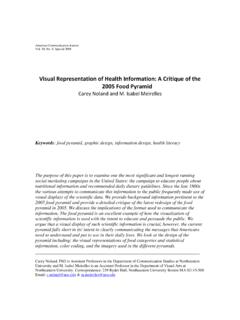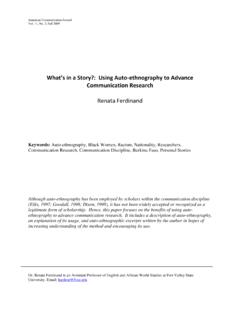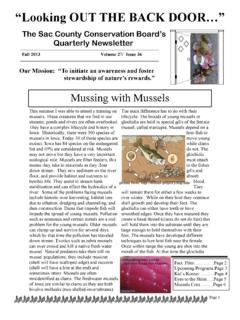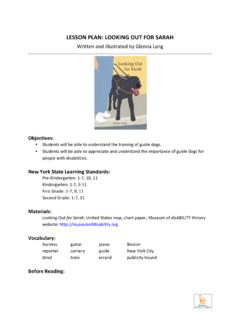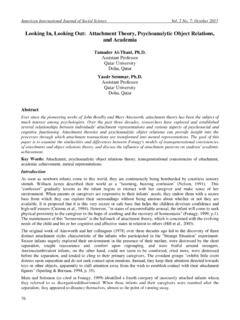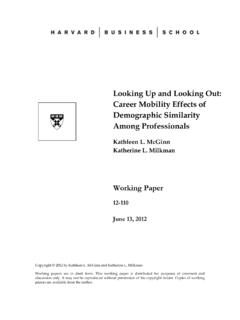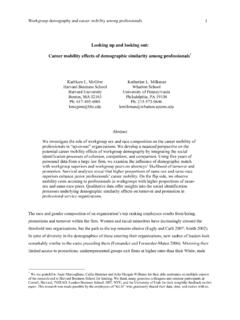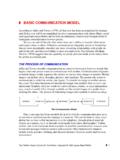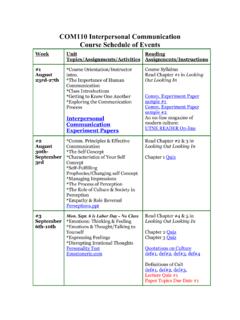Transcription of Interpersonal Communication: Relating to Others
1 Copyright 2000, 2001, ACJV olume 5, Issue 3, Spring 2002 Interpersonal communication : Relating to OthersBeebe, Steven, Beebe, Susan, and Redmond, MarkAllyn and Bacon, 2002428 pagesPaper: $59 US Reviewed by: Mari Miller Burns, Iowa Lakes Community CollegePrinter-friendly PDF versionWhat is the role of an Interpersonal communication textbook? Knapp and Vangelisti believe that part of this role is to identify several important patterns of communication as they manifest themselves at different stages of a relationship (p. ix). Adler and Towne intentionally wrote their editions of looking Out/ looking In in a personal a meeting of real individuals (p. vii). The author s self-proclaimed approach for Interpersonal communication and Human Relationships is an other -oriented approach (that) gently but consistently reminds students about the importance of the challenging process of seeing the world as Others see it (p.)
2 Xi). Is this other -oriented approach an effective strategy for an Interpersonal communication text? Some form of the term other -oriented is utilized less than twenty times throughout the entire text. They provide a role playing exercise in a building your skills feature (Chapter 1, p. 31), and an example of viewing the golden rule from various religious perspectives in an understanding diversity feature (Chapter 2, p. 41). The best job they do with this comes in the fourth chapter dealing with cultural diversity. Here they spend over four pages talking about specific ways to increase your other -orientedness (p. 120). Social decentering is one such way, yet the decentering process was previously talked about in isolation during chapter two.
3 The latter chapter makes no reference to the previous discussion of the same concept, perhaps causing some confusion for students. This other -oriented approach also looks at Interpersonal communication in the contexts of family and nonverbal communication . Probably the best way the authors accomplish the focus on Others is through the considering Others feature dispersed throughout all eleven Interpersonal textbook of the 21st Century certainly must address how the Internet and email influence our relationships. I was particularly delighted to see the special feature e-connections in every chapter, with some chapters containing several. An Interpersonal communication textbook is the perfect place to provide guidelines, tips, and relative websites.
4 Chapter six, Communicating Verbally, for example, contains four e-connections, evidence that computer-mediated communication is replacing much of what was previously face-to-face. Unfortunately, the e-connections that offer websites are problematic. Of the twenty-four websites provided, I could only access nine of them. Some of these were interesting by offering tests about personality types and relationship satisfaction, for example. Some websites I found particularly fun are: Shaver/ about developing relationships and that provides the Myers-Briggs personality test. Not to be able to access over sixty percent of the websites, however, made nearly half of the e-connections worthless. The idea for e-connections is commendable, but a few bugs need to be worked out for implementing two through seven of Beebe, Beebe, and Redmond s eleven-chapter text follow a familiar route: intrapersonal communication , Interpersonal communication , intercultural communication , listening, verbal communication , and nonverbal communication .
5 Personally, I want a textbook for my Interpersonal communication course that is not a makeover of my basic course text. I am not going to use a sweeping generalization (BeeBe, Beebe, & Redmond, p. 184) and succumb to allness (p. 184) by saying all of the text is just like all of the other basic texts. I would, however, like to see most of the text be mostly different from the basic text and more like an Interpersonal text. Let me qualify this in one situation. If you are teaching an Interpersonal course that fulfills the speech communication requirement at your college, this text would be a good choice. Students would still be exposed to various types of communication and important components in the communication process. If, however, you are teaching a course that truly seeks to explore one-on-one relationships in a myriad of settings, this text falls revisit my previous question: Is this other -oriented approach an effective strategy for an Interpersonal communication text?
6 In premise, I would concur, but in the practice of this textbook, I must disagree. They do periodically discuss its importance, but not sufficiently enough to consider it their theme. Throughout the book we have emphasized the importance of becoming other -oriented.." (p. 120). Throughout this text we have emphasized trying to look at interactions from your partner s perspective.. (p. 395). In my opinion, for an idea to be an emphasis, it must be given special importance and recognition, rather than an allusion that it has mysteriously been , and Towne, N. (1987). looking Out/ looking In: Interpersonal communication (5th ed.). Chicago: Holt, Rinehart and , and Vangelisti, (2000). Interpersonal communication and Human Relationships (4th ed.)
7 Boston: Allyn and to Top Home | Current Issue | Archives | Editorial Information | Search | Interact
